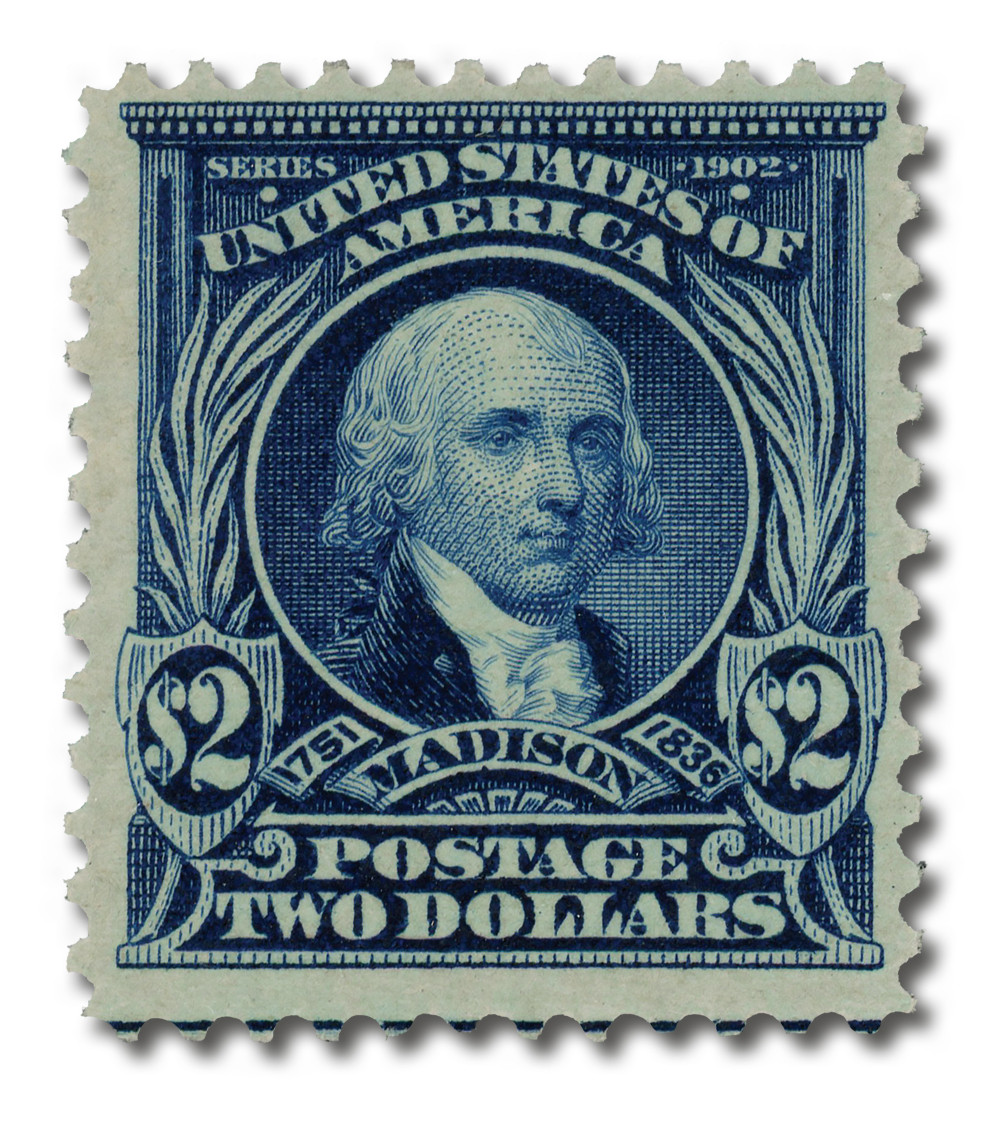
U.S. #312
Series of 1902-03 $2 Madison
Issue Date: June 5, 1903
Quantity issued: 37,872
Printed by: Bureau of Engraving and Printing
Method: Flat plate
Watermark: Double line
Perforation: 12
Color: Dark blue
The primary use for the Series of 1902-03 $2 and $5 stamps was to settle accounts between various post offices and the Post Office Department.
When publishers of newspapers and magazines requested their mail be changed from third to second class mail, an application was filled out at the local post office and mailed to Washington, D.C. At times, the Post Office Department took months to reach a decision. In the meantime, the publisher was allowed to send mail at the lower requested rate – if he placed on deposit the difference between the two rates.
If the request was ultimately granted, the deposit was refunded to the publisher. If it was denied, the local postmaster sent the deposit to Washington, D.C. To do so, the postmaster filled out a special form and the amount owed was sent in the form of postage stamps canceled with ink.
Because the applications often languished in Washington, the amount owed was often considerable, requiring high-value postage stamps for payment. These forms, with the stamps attached, were kept on file at the Post Office Department for a few months and then destroyed (although a few were given away). Because of limited postal use and the destruction of many of these stamps by the Post Office Department, U.S. #312 is quite scarce today.
In 1917, U.S. citizens began sending packages to war-torn Russia. Demand for high-value stamps rose at the very same time the inventory of $2 and $5 Series of 1902-03 stamps was nearly depleted. The stamps were re-issued (becoming U.S. #479 and #480), but with 10 gauge perforations that distinguish them from this issue, which has 12 gauge perfs.
Fourth President of the United States
James Madison, often called “The Father of the United States Constitution,” was an esteemed politician. One of America’s Founding Fathers, his extensive writing of the Federalist Papers is considered the most significant commentary on the Constitution, of which he was the chief author. He served as a leader of the first Congress and drafted many basic laws as well as the first 10 Amendments to the Constitution, earning him the title “Father of the Bill of Rights.”
Along with Thomas Jefferson, Madison was also one of the founding members of the Democratic-Republican political party, which eventually became the Democratic Party. As Secretary of State under Jefferson, Madison played a key role in the Louisiana Purchase. Following Jefferson’s popular administration, Madison easily won the 1808 presidential election over Charles Cotesworth Pinckney.
Madison’s administration was plagued by tension with the British, which led to the war of 1812. Despite the unpopular war, he was re-elected in 1812. The end of the war allowed Madison to work on other issues he was concerned with, such as The Bank of the United States.
U.S. #312
Series of 1902-03 $2 Madison
Issue Date: June 5, 1903
Quantity issued: 37,872
Printed by: Bureau of Engraving and Printing
Method: Flat plate
Watermark: Double line
Perforation: 12
Color: Dark blue
The primary use for the Series of 1902-03 $2 and $5 stamps was to settle accounts between various post offices and the Post Office Department.
When publishers of newspapers and magazines requested their mail be changed from third to second class mail, an application was filled out at the local post office and mailed to Washington, D.C. At times, the Post Office Department took months to reach a decision. In the meantime, the publisher was allowed to send mail at the lower requested rate – if he placed on deposit the difference between the two rates.
If the request was ultimately granted, the deposit was refunded to the publisher. If it was denied, the local postmaster sent the deposit to Washington, D.C. To do so, the postmaster filled out a special form and the amount owed was sent in the form of postage stamps canceled with ink.
Because the applications often languished in Washington, the amount owed was often considerable, requiring high-value postage stamps for payment. These forms, with the stamps attached, were kept on file at the Post Office Department for a few months and then destroyed (although a few were given away). Because of limited postal use and the destruction of many of these stamps by the Post Office Department, U.S. #312 is quite scarce today.
In 1917, U.S. citizens began sending packages to war-torn Russia. Demand for high-value stamps rose at the very same time the inventory of $2 and $5 Series of 1902-03 stamps was nearly depleted. The stamps were re-issued (becoming U.S. #479 and #480), but with 10 gauge perforations that distinguish them from this issue, which has 12 gauge perfs.
Fourth President of the United States
James Madison, often called “The Father of the United States Constitution,” was an esteemed politician. One of America’s Founding Fathers, his extensive writing of the Federalist Papers is considered the most significant commentary on the Constitution, of which he was the chief author. He served as a leader of the first Congress and drafted many basic laws as well as the first 10 Amendments to the Constitution, earning him the title “Father of the Bill of Rights.”
Along with Thomas Jefferson, Madison was also one of the founding members of the Democratic-Republican political party, which eventually became the Democratic Party. As Secretary of State under Jefferson, Madison played a key role in the Louisiana Purchase. Following Jefferson’s popular administration, Madison easily won the 1808 presidential election over Charles Cotesworth Pinckney.
Madison’s administration was plagued by tension with the British, which led to the war of 1812. Despite the unpopular war, he was re-elected in 1812. The end of the war allowed Madison to work on other issues he was concerned with, such as The Bank of the United States.















